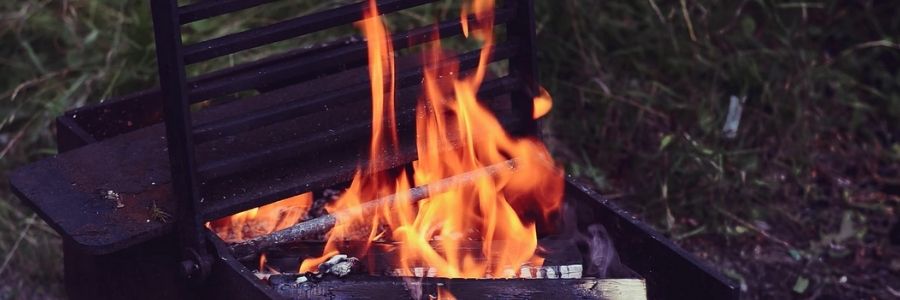If your smoker isn’t insulated, you’re likely leaking tons of heat and wasting firebricks every time you smoke chicken inside. The solution to this is learning to insulate your firebox. We’ll go over the different methods for this so that by the end, you have an idea of how to complete these projects.
Quick Summary
- Insulating a smoker firebox controls heat loss, promotes even cooking, and adds safety. Methods include using insulation jackets, blankets, welding blankets, or cement boards.
- The thickness of insulation depends on factors like outside temperature, with an average thickness around 1 inch.
- The method of insulation may vary based on the shape of the grill, with blankets suitable for circular grills and cement boards for angular surfaces.
What Are the Benefits of Insulating a Smoker Box?

There are quite a few benefits of insulating a smoker box ranging from temperature control to safety issues.
The primary reason most people will decide to protect their smoker is better cooking consistency.
Because heat loss is better controlled, it promotes an even cooking surface, making temperature control much more manageable.
One other reason we commonly hear people use for insulating their firebox smoker is the added safety benefits.
Because the outside walls are less hot, children and pets are at a lesser risk of burning themselves if they contact the outside surface.
Difference Between Insulated and Non-Insulated Smokers

The main difference between insulated and non-insulated smokers is in the materials used for construction.
Smoker manufacturers who insulate their smoker will typically use construction supplies such as insulation blankets, insulation jackets, or a similar fabric layer.
There is also a stark contrast in how evenly and thoroughly the two will cook met.
Because the insulated fireboxes for smokers contain heat much better, the heat is distributed throughout the pit much more evenly.
This also means you will be using less fuel to keep the temperature even because of this heat retention.
How Thick Should Your Insulation Be?
The thickness of insulation is usually measured in either inches or centimeters. The actual thickness you want for your specific charcoal grill or firebox for smoker will depend on a few different factors.
One of the primary things to take into consideration is the temp outside (1). If you live in a colder country and plan to use your fire box smoker in colder temperatures, thicker insulation is the way to go.
However, if you are only looking to keep the outside of the metal protected and cool, a thinner insulation piece is sufficient. Generally, the average insulation blanket is around 1 inch (2.54 centimeters). Once you know whether you need thicker or thinner insulation, you can work from there.
What Are the Different Methods of Insulating a Firebox?
There is not one single method for creating an insulated firebox. For that matter, all of the different insulation methods can be appropriate depending on what you want the result to be.
1. Using Insulation Jacket
Insulated grill jackets are stainless steel layers that are usually installed in built-in BBQ grills. These are used to keep heat in and protect the surrounding pieces if the cooking chamber is made from combustible materials. These jackets are usually made from stainless steel.
2. Using Insulation Blanket
An insulation blanket is method two for creating an insulated firebox. These generally cost less money and are a lot more accessible. These blankets fit over the smokers firebox and can be secured into place using straps.
3. Using Welding Blanket
A welding blanket is another method for creating an insulated firebox. These are used to protect welders. Because they are insulated and protect against heat, they also help keep the heat from escaping your smoker’s sides. Make sure to wrap the blanket around the grill as many times as needed.
“Concrete generally exhibits good fire resistance properties”
- Noor Shahedan, Center of Excellence Geopolymer and Green Technology Page (2)
4. Using Cement Board
Cement board can line the smoker and firebox inside to help keep heat from escaping. The cement board is made from mixing cement and part fibers to create sheets. Cement board panels come in different thicknesses. We recommend a cement board for flat surfaces.
What Should You Know About Insulating a Firebox?

You must get the original measurements correct, whatever method you decide to use to insulate your smoker. We recommend using a tape measure to get the exact sizes, so you know the amount you need to insulate your firebox.
Make sure you insulate all sides and the top and bottom of the smoke grill. If everything is in place, then you won’t have to worry about things like cold weather affecting your meat cooking. When putting your aluminum layer or metal jacket into place, make sure that you still have access.
Related Articles:
Insulating a Vertical Smoker vs. a Horizontal Smoker
Whether you have a vertical smoker or a horizontal smoker won’t affect the material you use as much as the grill’s shape. For example, if you have a circular grill, using the insulation blanket can be a good way to save on fuel without adding a bunch of extra weight.
On the other hand, if your smoke grill is square, using an option such as a cement board may be a better method. These can help keep heat in your grill while needing less fuel to cook your chicken and other meat or food.
Recommended Article: Most Recommended Vertical Pellet Smokers









Is there any foam insulation spray available that I can use to insulate my firebox on my smoker ?? I am adding an additional round tube in my square firebox however want to spray foam insulation around the tube for sealing the heat .
Hi Frank,
To be honest, I haven’t used any insulation spray on my smokers so far. If you happen to find a good one, I’d be more than happy to hear about it!